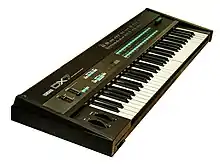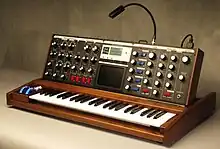_%2540_Stearns_Collection_(Stearns_2035)%252C_University_of_Michigan.jpg.webp)
The analog revival is a period in synthesiser history when analog synthesizers recommenced production and mainstream usage. The revival has its roots in the late 20th century but began in earnest during the early 21st century, prompted by the release of several analogue synthesizers by companies like Korg and Moog. This followed a spell of companies producing digital synthesizers after the release of Yamaha's DX7, which was less expensive than analog synthesizers and led to many analog manufacturers going out of business in the 1980s. The emergence of electronic dance music in the late 1980s gave a boost to analog synthesizers, which saw use due to their availability on the second-hand market. The growing demand for analog created by this movement was not capitalised on fully for some time: it took until the early 20th century for major manufacturers to begin producing analog synthesizers again.
Background

Analog synthesizers have been produced since the 1960s when Robert Moog created his modular synthesizer. The synthesizer became widely popular following Moog's 1970 release of the Minimoog, which was more affordable than its much larger predecessor. Analog synthesizers thrived in this period, with artists like The Beatles, Rush, Lipps Inc. and Michael Jackson all using analog synthesizers in their music. In 1983, Yamaha released their DX7 digital synthesizer, which was cheaper than its analog counterparts. Many studios and producers began to neglect analog synthesizers, increasingly using digital synthesizers into the late 1980s and 1990s.[1] Analog synthesizer companies could not keep up with the competition and many, including Moog, ARP and Sequential Circuits went out of business in the 1980s.[2][3][4][5]
History
20th century: dance music revival
Despite the boom in digital synthesizers and their effect on analog manufacturers, analog synthesizers maintained some relevance throughout the later 20th century. The mainstream emergence of electronic dance music in the summer of 1988 is cited as contributing to the "evolution of analog synth aesthetics" by Gaute Barlindhaug. Through the form of clubbing and raves, this movement relied on analogue synthesizers and drum machines created by the Roland Corporation several years prior. Roland's TR-808, TR-909 and TB-303 were commercial failures at release due to their analog sound at a time when realistic sounds were wanted by musicians. Already seen as outdated, units of these machines were available for resale at low prices on both sides of the Atlantic, making them an attractive entry point for amateur musicians.[5] These musicians would go on to use these instruments in house, techno, hip-hop and other genres, creating a wider interest in analog synthesizers.[6] However, during this period mainstream music was still using digital synthesizers and samplers.[5] Analog synthesizer manufacturers were unable to capitalise on this demand anyway since most were out of business; those that remained had embraced digital synthesis and did not want to return to analog.[7]
By the 1990s, some companies tried to appeal to the growing analog revival by releasing virtual analog synthesizers. Roland released their JD-800 in 1990: while digital, it marked a return to analog-like controls, oscillators and filters.[7] Tom Oberheim returned in 1993 to release the Marion Systems MSR2, a rack-mount synthesizer with digitally controlled analog oscillators.[8] In 1994, Doepfer and Novation released their analog synthesizers: Novation's Bass Station was one of many TB-303 inspired synthesizers released in this period.[9] Others entered the market towards the end of the century, with virtual analog offerings from Waldorf, Quasimidi and other smaller manufacturers appearing in lieu of major companies.[10]
21st century: mainstream revival
The analog revival began in earnest during the early 21st century;[11] its beginning is attributed to multiple events, including the release of the Minimoog Voyager in 2002 by the reformed Moog Music,[12] the release of the Korg Monotron in 2010[13][14] and the re-release of several manufacturers' vintage synthesizers.[15] Prior to this date, analog synthesizers enjoyed a small amount of use in the second-hand market that existed during the period of digital prominence in the late 20th century.[16] During the early 2000s this was still the case, despite the increasing availability of new analog synthesizers.[17]
Modular synthesizers, specifically Eurorack, played a part in the analog revival by causing major manufacturers such as Moog, Roland and Korg to start making new analog synthesizers.[18] Trade shows such as the NAMM Show reported large increases in the number of modular synthesizers in the year 2015; the same year there was a 20% increase in synthesizer offerings at the show.[11] The manufacturing switch to surface-mount technology also contributed to the analog revival, as new analog synthesizers were able to be made faster and for lower costs.[13] The mass production of small analog synthesizers was another factor, as previous designs suffered due to being costly and unwieldy.[19]
This analog revival began due to a number of perceived advantages that analog synthesizers have over their digital counterparts. Sound on Sound magazine stated that one of these reasons was the imperfections present in the sound of an analogue synthesizer, which can make the instrument feel less "sterile".[13] Tom Oberheim said that "there is a warmth to analog", and compared the analog–digital divide to LPs and CDs.[15][note 1] They also suggested that the simple layout and "one-knob-per-function" design help to make a more instant connection with the player.[12][13][21] Oberheim and Dave Smith both theorised that the demand could be due to a cohort of younger musicians discovering analog synthesizers.[22] Steve Oppenheimer of Electronic Musician suggested that a factor was that musicians wanted digital and sample-based synthesizers over analog because they could emulate acoustic instruments better, but a new appreciation of analog by electronic musicians caused an "analog renaissance".[17]
As well as the production of new analog synthesizers, the analog revival has manifested in other ways: vintage synthesizers are now being sold for large amounts due to demand from modern producers. Digital synthesizers are also beginning to display traits associated with analog, like more hands-on controls.[23]
Notes, references and sources
Notes
References
- ↑ Stefani 2022, p. 337.
- ↑ Sherburne, Philip (2 February 2015). "Jacking Into the Past with the Vintage Synth Revival". Pitchfork. Retrieved 12 November 2023.
- ↑ Mast, Lindsay Wolfgang (23 March 2023). Synthesizer comeback (Radio broadcast). World Radio. Retrieved 12 November 2023.
- ↑ The Music Trades 2016, p. 82.
- 1 2 3 Jenkins 2007, p. 194.
- ↑ Barlindhaug 2007, p. 80.
- 1 2 Jenkins 2007, p. 197.
- ↑ Jenkins 2007, p. 198.
- ↑ Jenkins 2007, p. 199.
- ↑ Jenkins 2007, p. 202–203.
- 1 2 Rodgers 2015, p. 5.
- 1 2 Boothroyd, David (13 August 2013). "Analogue electronics sees a revival in the music industry". New Electronics. Retrieved 11 August 2023.
- 1 2 3 4 "The Analogue Revival". Sound on Sound. March 2014. Retrieved 11 August 2023.
- ↑ "So many synths, so little time". Mixdown. Retrieved 11 August 2023.
- 1 2 Lewis, Randy (21 January 2015). "The synth is back: KORG and Moog revive golden-era analog synthesizers". Los Angeles Times. Retrieved 11 August 2023.
- ↑ Doty, Marc (14 July 2016). "What's Behind The Resurgence of Analog Synthesizers?". Performer. Retrieved 11 August 2023.
- 1 2 Oppenheimer 2006, p. 10.
- ↑ Boxer, Steve (8 July 2015). "The synth revival: why the Moog is back in vogue". The Guardian. Retrieved 11 August 2023.
- ↑ Stefani 2022, p. 338.
- ↑ Barlindhaug 2007, p. 78.
- ↑ Vanhanen, Janne (29 December 2016). "Rewired – the Resurgence of Analog Sound Synthesis". Mustekala Kulttuurilehti. Retrieved 11 August 2023.
- ↑ The Music Trades 2016, p. 84.
- ↑ Pinch & Trocco 2002, p. 317.
Sources
- "An Analog Revival at NAMM". The Music Trades. 164 (2): 82–84. March 2016. ISSN 0027-4488.
- Barlindhaug, Gaute (2007). "Analog Sound in the Age of Digital Tools". In Lund, Niels Windfeld; Skare, Roswitha; Vårheim, Andreas (eds.). A Document (Re)turn. Frankfurt: Peter Lang. pp. 73–93. ISBN 9783631562949.
- Jenkins, Mark (2007). "The Analog Revival". Analog Synthesizers. Elsevier. pp. 194–229. ISBN 9780240520728.
- Oppenheimer, Steve (June 2006). "The Analog Revival". Electronic Musician. 22 (6): 10. ISSN 0884-4720.
- Pinch, Trevor; Trocco, Frank (2002). Analog Days: the Invention and Impact of the Moog synthesizer. Cambridge, Massachusetts: Harvard University Press. ISBN 9780674016170.
- Rodgers, Tara (October 2015). "Tinkering with Cultural Memory". Feminist Media Histories. University of California Press. 1 (4): 5–30. doi:10.1525/fmh.2015.1.4.5. eISSN 2373-7492.
- Stefani, Ewan (2022). "The Analogue Synthesizer: Classification, Design and Musical Potential". In Doğantan-Dack, Mine (ed.). Rethinking the Musical Instrument. Newcastle upon Tyne: Cambridge Scholars Publishing. pp. 337–359. ISBN 9781527577893.
External links
- Feature on MusicRadar

_(cropped).jpg.webp)